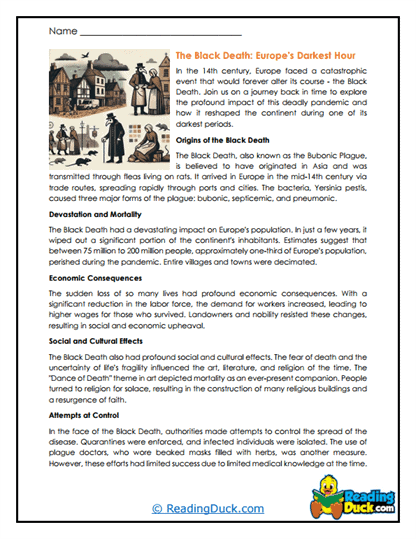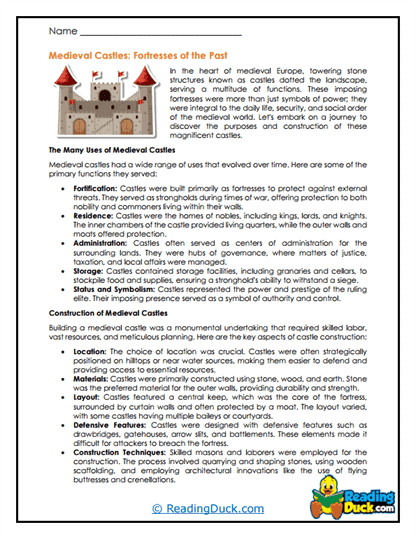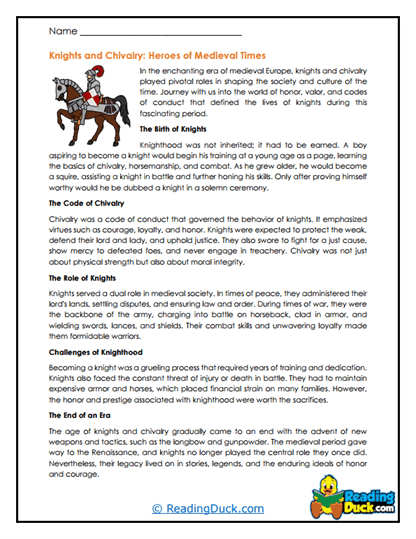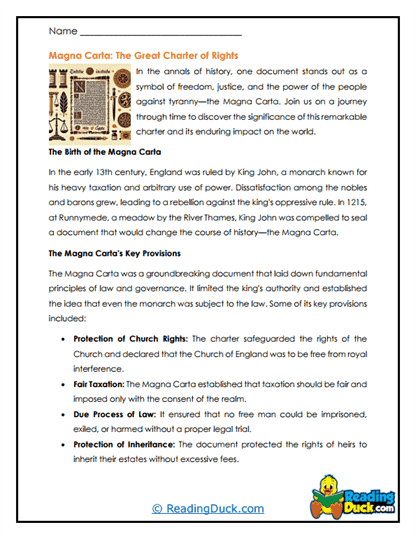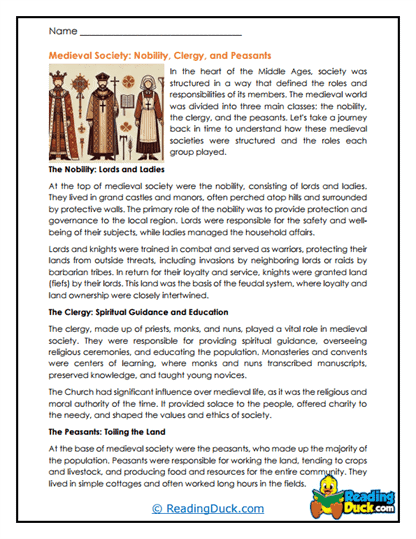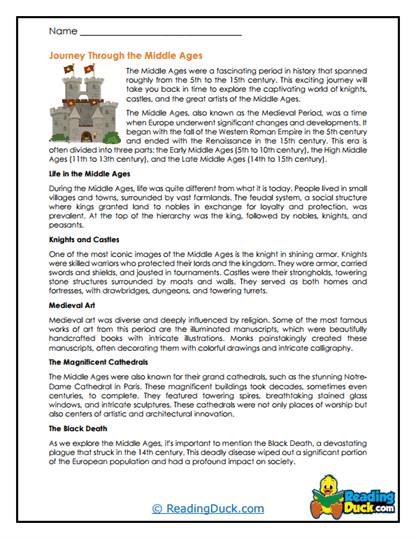Middle Ages Worksheets
About Our Middle Ages Worksheets
The Middle Ages, also known as the Medieval period, spanned roughly from the 5th to the late 15th century and were a time of great social, political, and religious transformation. Our collection of Middle Ages worksheets dives into the key events, figures, and cultural shifts of this era, giving students a rich understanding of life during this pivotal period in history. Each worksheet set is thoughtfully designed to engage students and deepen their comprehension of the Middle Ages through a variety of learning formats.
Every topic in this collection contains several worksheet sets, covering different aspects of the Middle Ages, from feudalism and the rise of kingdoms to the influence of the Church and the Crusades. Each worksheet set includes:
- Multiple Choice Questions: These questions assess students' understanding of the key facts, events, and figures from the Middle Ages.
- Short Answer Questions: These questions encourage students to write their own responses, diving deeper into the causes and effects of historical events or the motivations of historical figures.
- Open-Ended Questions: These questions challenge students to think critically and provide their own opinions or reflections, helping them connect historical lessons to modern-day contexts.
Answer keys are provided for every worksheet, and the PDF format ensures easy access for electronic viewing, downloading, or printing.
A Glimpse into Medieval Life: Exploring the Middle Ages
The Middle Ages was a complex and transformative time in world history. Often divided into three distinct periods—early, high, and late Middle Ages—this era was marked by the rise and fall of empires, the spread of Christianity, the establishment of feudalism, and the eventual cultural revival known as the Renaissance. Here's how teachers might introduce the topic of the Middle Ages to students.
1. The Early Middle Ages (500-1000 AD):
- The Fall of the Roman Empire: The collapse of the Western Roman Empire in 476 AD led to the beginning of the Middle Ages. The power vacuum left behind allowed various barbarian tribes to establish kingdoms across Europe.
- The Rise of Feudalism: With the collapse of centralized government, feudalism emerged as the dominant political system, where land was exchanged for military service, and the nobility, clergy, and peasantry had distinct roles within the system.
- The Influence of the Church: The Christian Church, particularly the Catholic Church, became a powerful force in Europe, providing spiritual guidance and political influence. Monasteries preserved knowledge, and bishops often wielded political power.
2. The High Middle Ages (1000-1300 AD):
- The Crusades: Starting in the late 11th century, the Crusades were a series of religious wars initiated by European Christians to reclaim the Holy Land from Muslim control. These wars had profound social, political, and economic consequences for Europe and the Middle East.
- The Growth of Towns and Trade: The High Middle Ages saw a resurgence of urban life, with the growth of towns, trade, and guilds. This economic shift helped to weaken the feudal system and laid the groundwork for the rise of the merchant class.
- The Power Struggle Between Church and State: As monarchies grew stronger, conflicts arose between secular rulers and the Church, with famous confrontations such as the Investiture Controversy, which centered on the appointment of church officials.
3. The Late Middle Ages (1300-1500 AD):
- The Black Death: One of the most devastating pandemics in human history, the Black Death struck Europe in the 14th century, killing an estimated one-third of the population. This had profound effects on the economy, social structures, and religious beliefs.
- The Hundred Years’ War: A prolonged conflict between England and France, the Hundred Years' War (1337-1453) helped shape national identities and saw the rise of figures like Joan of Arc.
- The Renaissance and the Decline of Feudalism: The cultural and intellectual revival known as the Renaissance began in the late 14th century, signaling the end of the Middle Ages. The rise of humanism, new forms of art, and the decline of the feudal system paved the way for the modern era.
By guiding students through these historical periods, teachers can help them understand the intricate web of events, ideas, and cultural practices that defined the Middle Ages.
The Lasting Significance of the Middle Ages
1. The Foundation of Modern Europe:
- Feudalism and Governance: The feudal system laid the groundwork for the development of modern political structures. Many of today’s concepts of land ownership, governance, and social hierarchy evolved from the practices of feudalism.
- The Power of the Church: The Catholic Church’s influence during the Middle Ages shaped the religious, political, and cultural landscape of Europe. The Church's role in education, governance, and social services continues to echo in modern institutions.
2. Cultural and Intellectual Legacy:
- The Gothic Cathedrals: The Middle Ages produced some of the most awe-inspiring architectural feats, such as the towering Gothic cathedrals. These structures remain as a testament to the artistic and engineering prowess of medieval Europe.
- Literature and Language: The Middle Ages saw the development of vernacular literature, with works like "The Divine Comedy" by Dante and "The Canterbury Tales" by Chaucer. These texts helped shape modern European languages and literary traditions.
- The Renaissance Connection: The intellectual revival of the Renaissance, often seen as a reaction to the perceived stagnation of the Middle Ages, was built upon the foundations laid by medieval scholars, philosophers, and artists. Figures like Thomas Aquinas and medieval universities played a key role in preserving and advancing knowledge.
Creative Ways to Use Middle Ages Worksheets in the Classroom and Beyond
The Middle Ages can be a challenging topic to teach, but these worksheets make it engaging and accessible for students. Here are some tips on how teachers and parents can use the worksheets effectively:
In Social Studies Classes:
- Timeline Creation: Have students use the information from the reading passages to create detailed timelines of key events during the Middle Ages. This helps them visualize the chronological flow of historical events.
- Debates on Feudalism: Assign students different roles within the feudal system (noble, knight, serf, etc.) and host a class debate on the advantages and disadvantages of feudalism. This encourages critical thinking and active participation.
- Crusades Role-Play: Divide students into groups representing different historical figures from the Crusades. Have them role-play interactions and negotiations, helping them understand the motivations and complexities of the Crusades.
Cross-Curricular Connections:
- Art and Architecture: Use the worksheets as a starting point for an art project where students create models or drawings of medieval castles, cathedrals, or towns. This fosters a hands-on understanding of medieval engineering and design.
- Literature Connections: Pair the worksheets with medieval literature, such as "Beowulf" or excerpts from "The Canterbury Tales." Students can explore how these literary works reflect the values and beliefs of medieval society.
- Scientific Discoveries: Explore how the Middle Ages contributed to scientific advancements. Topics like medieval astronomy, medicine, and the use of technology in warfare can be paired with science lessons.
Home Learning and Family Engagement:
- Family Discussions: Encourage students to share their knowledge of the Middle Ages with their families. They can lead discussions on topics like the Black Death, the importance of the Church, or the development of towns and trade.
- Interactive Quizzes: Turn the multiple-choice questions from the worksheets into a fun family quiz night. This is a great way for families to bond while reinforcing students’ understanding of the material.
- Virtual Museum Tours: Many museums offer virtual tours of medieval exhibits, such as armor, manuscripts, and relics from the Middle Ages. Combine these tours with the worksheets for a more immersive learning experience.
By using these Middle Ages worksheets creatively, students can gain a deeper appreciation for the period and its lasting influence on the modern world. From social studies classes to interdisciplinary projects, these worksheets open the door to exploring a time of knights, castles, cathedrals, and significant historical change.
